|
Weird, Eccentric and Everyday Gadgets and Contraptions from the Past
“WHAT A LOT OF CODD’S WALLOP!”
Or how I became a collector of weird, eccentric and everyday gadgets and contraptions from the past
By Maurice Collins
All photos courtesy of the author
Posted March 2017

It all started down a hole in the ground in a Victorian rubbish dump in North London. My son, aged 13, decided that he wanted to dig for old bottles and pot lids in a local dump.
“Whatever for?” I queried.
“My mates are doing it. They saw it on the telly.”
This was back in the Seventies. A television programme had featured a group of teenagers helping to excavate a rubbish dump. For a very short time, it became a craze. Sounds a bit sad now, but remember, there were no computer games, smart phones or virtual reality back then. So, off we went to the dump.
Here we were, down this dirty, damp trench in foul weather, and the only thing we could find on that first dig was a bottle with a pointed bottom that would not stand up. Yet, how intriguing: a bottle that was impossible to stand on its own two feet—what was the point? (No pun intended). My son didn't see the point, either, but Dad was hooked. I became a gadget nut with an interest in patents, inventions and weird contraptions. Most of my collection has come from antique fairs, dealers and by personal recommendation, but if you can get access to very old rubbish tips (garbage dumps), and make sure you are working safely, you never know what you might find.
|
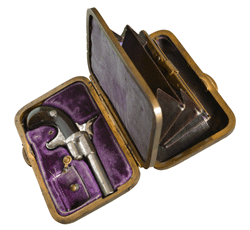
|
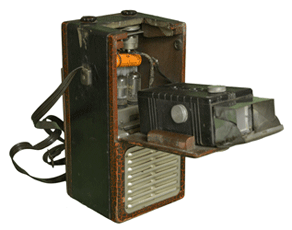
|
|
Gun purse
|
Radio camera
|
I love researching gadgets. My first mystery was why the Victorians bothered manufacturing bottles that quite deliberately fell over. Joseph Priestley, the 18th century English scientist, was best known for his discovery of oxygen; yet, he always said that his happiest discovery was his invention of soda water. He found a way to carbonate water. Every bubbly, fizzy drink since then owes a debt to Joseph Priestley who ended his years living in Pennsylvania. Everyone wanted sparkling mineral water. The problem was how to keep the fizz in and prevent the drink from going flat.
In 1814, a man named William Hamilton came up with an ingenious solution. He reasoned that if the cork in the neck of the bottle was always kept damp, the gas could be kept in the bottle. To do this, Hamilton devised the pointed-bottom bottle. As it was always on its side, the liquid was always in contact with the cork. It was a huge success. In fact, it continued for nearly 100 years, even when competition from the more famous mineral water container called the Codd's bottle came along in the 1880s. This was invented by Hiram Codd and was a normal bottle with a kink in the neck that held a marble. The pressure of the gas in the bottle pushed up on the marble, thus sealing it. The idea of it being just a lot of gas gave rise to the expression, “What a lot of codd’s wallop.” A wallop is English slang for a drink, and the saying means talking a lot of gas.
|
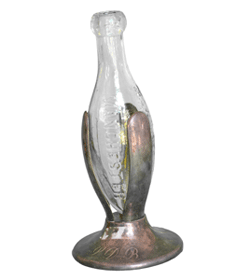
|
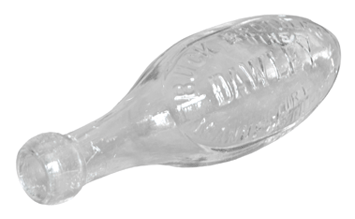
|
|
Hamilton bottle with holder
|
Hamilton bottle
|
Victorian kids had a great time breaking the Codd's bottles to get at the marbles; I had a lot of fun finding out how they worked. Just a little research had opened for me an amazing insight into how people over a period of 100 years had used technology in their everyday lives, and I resolved to try to collect the minutiae of everyday life. In the end, my collection runs to more than 2,000 gadgets. A wide range of these are now represented in a book on my collection, Bizarre and Outlandish Gadgets and Doohickeys.
When I started to collect these contraptions, I realised the enormity of the task. After all, stores had been selling these products in their tens of thousands so I needed to set some parameters to the collection. Being based in London, I decided to make my period 1851–1951 (from the Great Industrial Exhibition to the Festival of Britain). I also went for as many mechanical gadgets as possible, and especially as time went on, I became more and more interested in patents and gadgets that were beautiful or ingenious or both, yet which never quite made it.
|
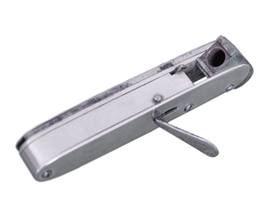
|
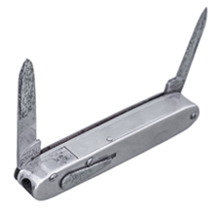
|
|
Penknife gun
|
|
Just collecting for its own sake has never been my motivation. Right from the start, I wanted to know the social background. How was this particular invention meant to improve people's lot? Did it reduce manual labour? Was this the result of higher labour costs, or did the new technology lead to unemployment and higher rates of poverty? Why did it succeed, or why did it fail?
Also of interest are the missing links, the steps on the way to the machines of today. Take the washing machine. For centuries, women—nearly always women—had scrubbed clothes clean with stones by a river or used a tub and a dolly-stick (a stick for moving laundry from a tub of boiling water to a tub of rinse water). The first mechanical washing machine replicates many of these actions. It is, however, identifiably the precursor of today's washing machines, though made of wood. It was still labour-intensive: you need strong arms to turn the handle fast enough for the clothes to be pummelled by the wooden ridges inside the barrel. However, it was a step away from drudgery and hard physical labour.
|
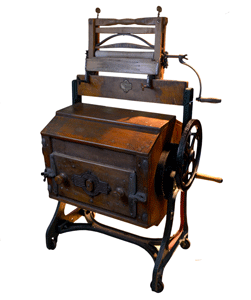
|

|
|
Early wooden washing machine
|
Teasmaid for automatically making tea.
|
What should you buy? Sometimes, monetary gain is very far from your head. I could not pass up the chance to own a “Teasmaid” powered by clockwork. It was simply too delightful, and the mechanics of it are nearly perfect: you set the time on the alarm clock, when the bell rings, a series of levers causes a match to strike, which then lights an oil burner. When the kettle boils, a steel plate swivels and puts out the flames, and the water is poured automatically from the kettle into the teapot alongside the machine. It is, in truth, a fire hazard, but it is also a beauty.
Little by little, my collection grew. I am now well-known amongst specialist antique dealers, and they approach me, so I tend not to spend hours trawling websites for gadgets. I built up my early collection through hours of attending antique fairs, popping in to second-hand shops, and poking about in antique shops. Today, you may well have to spend that time on websites, but I would still strongly recommend going out and attending shops and fairs. Apart from anything, they are great places to meet people.
My latest book has been divided into specific sections, each dealing with a different area of gadgetry. Few areas are untouched in my collection. There is the self-illuminated clock, candle-powered, in the Time and Money section, and the portable cheque writer, patented in the USA, which embossed the amount over the writing to prevent fraud. The Quackery section illustrates some of the most amazing scams committed by the charlatans of the 1800s: the electric chain belt, which was said to cure everything from cancer to lack of potency, and another that changed the shape of your nose—looks like pure torture!
|
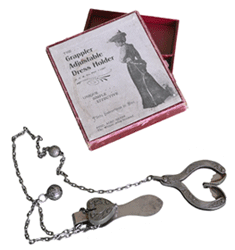
|
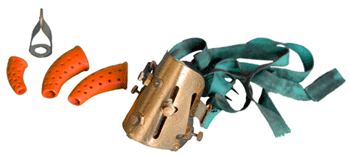
|
|
Skirt grappler
|
Nose shaper
|
An essential element of the collection is new-fangled inventions, items like the radio camera from the 1930s and the ladies’ detective camera in a make-up box—honey traps to blackmail politicians or businessmen are nothing new! The Ladies section is one of my favourites, reflecting the Victorian period in fashion with for example, skirt grapplers, which allowed the ladies of the day to go upstairs without tripping and to keep their skirts out of the mud in the streets.
Wars threw up a whole raft of interesting gadgets: escape items in WWII, such as uniform buttons that undo to reveal a compass and the roller skates issued to Britain’s Home Guard to fight the German Panzer Divisions if they ever landed on England’s shores.
Defending oneself in the heyday of the gangster was solved by having in your pocket a penknife that was also a revolver, called “the Defender,” a well-engineered little weapon that presumably did the job to dissuade the local hood. The Ladies section brings a Victorian edge to the idea of discreet defence. One of the most extraordinary items in the collection is a velvet lady’s purse that has concealed in the back of it a tiny pistol—it would certainly scare the footpad (highwayman); one just hopes it rarely had to be used.
So, why not build your own collection of these lost and forgotten works of the inventors of the past, contraptions which they hoped would make life easier, and at the same time, make them rich and famous? Scour antique fairs, the Internet, second-hand shops and pawnbrokers. Have fun—you will be amazed at the gadgetry that is still out there waiting to be discovered.
------------------------------------
Maurice Collins has been building his collection of 2,000 original contraptions and devices for 40+ years, and it has been exhibited in more than 30 museums across Europe. He is the author of: Kith and Kids, the story of his daughter who is learning disabled and the beginning of a self-help and support group of families, published by Souvenir Press; Ingenious Gadgets published by David and Charles; and Eccentric Contraptions, published by David and Charles.
About himself, Maurice writes, “I was born in a slum area of London, Hackney by name, just outside the sound of Bow Bells, which means that I am not a cockney by just a few hundred yards. I was evacuated in WWII for five years. On my return to London and to my parents, I went to a Grammar school, left when I was 14, was apprenticed as a compositor to a letter press printer, and then went into the Royal Air Force. Afterwards, I was married and had two children, Kim, who sadly was severely learning disabled, and Paul, who has two wonderful children. I started my own printing company in 1961, and after some years of running a range of businesses, I retired and spent some wonderful times building my collection. I was widowed in 2010, and now, I have a partner Janet who joins me in my trawling the markets of the world. I received an Honorary MA and an OBE for work in the field of learning disability.”
Editor’s note: An OBE, the Most Excellent Order of the British Empire medal, is according to The Official Website of the British Monarchy “…the order of chivalry of British democracy,” and it “…recognises distinguished service to the arts and sciences, public services outside the Civil Service, and work with charitable and welfare organisations of all kinds.”
The latest book on Maurice's collection is Bizarre and Outlandish Gadgets and Doohickeys, and it contains nearly 1,000 images of eccentric and ingenious contraptions he has collected over 40 years. The book is divided into sections, covering “Time and Money” through “Leisure Time and Keeping Fit,” 24 areas of social history reflecting 100 years of everyday products that would have been purchased across a shop counter. It is published by Schiffer Publishing and is available for $60.
|